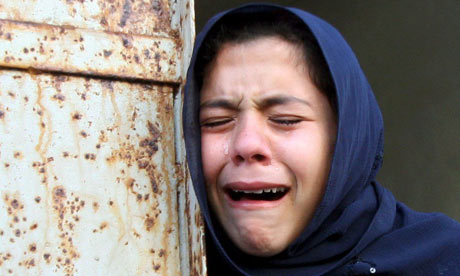Medical teams find ‘unbelievable’ horror amid rubble

Mourning relative in Gaza . Photograph: Mohammed Saber/EPA
Ambulances were able to drive to some of the most heavily shelled areas in Gaza for the first time to collect the dead and injured yesterday, as Israel paused its military offensive for three hours to allow in aid, amid growing international pressure to call a ceasefire and ease the humanitarian crisis.
A team of medics and volunteers from the Palestinian Red Crescent took advantage of the lull in fighting to drive to Zeitoun, the scene of an Israeli attack on a house on Monday that was known to have killed nine members of the Samouni family. It was the first time medics had been able to reach the scene.
Muhammad Shaheen, a volunteer with the Red Crescent, said the team found a scene of devastation. They discovered another 10 corpses inside the house and “dozens” more dead lying in the rubble in the area around.
“It was an unbelievable sight,” he said. “There was a huge number of dead bodies, houses were completely destroyed and many others partially destroyed.” The team found around 10 injured people in the house and another 15 who were unhurt, but still sheltering from the fighting.
As aid trucks drove in, many Palestinians left their homes to shop and stock up on food while they could. “Food and milk – what else can we hope for in three hours,” said Ahmed Abu Kamel, a father of six who lives near Gaza City . “We want it all to end.”
Several Israeli tanks were close by, next to the remains of the Israeli settlement at Netzarim, which has become a key Israeli military position during this conflict. The troops told the medical teams to park their vehicles and walk to the house to collect the dead and injured. All were brought back to Gaza City .
“We tried to help as much as we could, but it was hard to get access to the whole area. The roads were destroyed, there was rubble everywhere,” said Shaheen.
Some Israeli officials suggested that similar pauses in the fighting would be held every afternoon during the conflict. Peter Lerner, an Israeli military spokesman who works on the crossings, said lulls would be considered. Even during the pause in operations, Israeli soldiers might still fight, he said. “For every attack against the army, there will be a response,” he said.
But aid workers said three hours was not enough to allow sufficient relief into Gaza after months of an Israeli economic blockade. John Ging, director of operations for the UN Relief and Works Agency in Gaza, said it was a “hell on earth … Let’s stop the fighting, not just for three hours, but for 24 hours a day,” he said. “There’s nowhere safe in Gaza . Everyone here is terrorised and traumatised.”
There were occasional explosions heard across Gaza during the three-hour lull, and just minutes after it had expired the fighting returned. Israeli military helicopters were seen in the sky and there were several heavy explosions that sent up thick clouds of black smoke. Two rockets fired from Gaza streaked through the sky and landed in the southern Israeli town of Be’er Sheva . More rockets followed yesterday evening.
The death toll continued to mount. Last night, an Israeli air strike on a car killed a man and his three children in northern Gaza , Palestinian medical officials said.
At least 28 Palestinians were killed yesterday in attacks across the Gaza Strip, according to Palestinian medical officials. The overall Palestinian death toll was at more than 660, with nearly 3,000 injured. Journalists are still banned from entering Gaza to report on the killings. On the Israeli side, seven soldiers and three civilians have been killed in the past 12 days.
In a separate incident, the aid agency Care International said one of its staff on a food distribution project was killed on Tuesday night when his home was hit by an Israeli air strike. Muhammad Samouni died in the attack and his son was critically injured, the agency said.
Although lorries carrying medical supplies and food were allowed into Gaza yesterday, along with deliveries of industrial diesel, concern about the crisis is still growing. The World Bank warned there was a threat of a severe public health crisis because of a shortage of drinking water and the failure of the sewage system. Nearly all sewage and water pumps were out of operation because of a lack of electricity and limited fuel, it said.
Even when fuel was delivered, it was too dangerous to take it to the pumps where it was most needed, the bank said. It said that as well as fuel, a regular electricity supply was needed and maintenance work was urgently required on a large sewage lake in Beit Lahiya that was in danger of bursting.
“As of today, nearly the entire population of Gaza is without running water and is dependent on their own stored water supplies and limited sales by private water distributors,” the bank said.
Sewage had already flooded in some areas, it said, and warned that as many as 10,000 Palestinians were at risk of drowning if the Beit Lahiya sewage lake burst.
http://www.guardian.co.uk/world/2009/jan/08/aid-ceasefire-gaza-israel-palestinians

